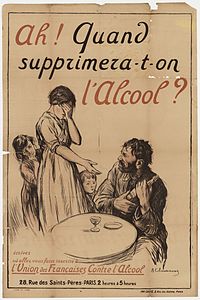
Photo from wikipedia
Compared with men, women are disproportionately affected by alcohol, including greater risks of physiological damage, behavioral impairment, and relapse. One likely mechanism underlying the sexual disparity in this vulnerability is… Click to show full abstract
Compared with men, women are disproportionately affected by alcohol, including greater risks of physiological damage, behavioral impairment, and relapse. One likely mechanism underlying the sexual disparity in this vulnerability is the fluctuation of ovarian hormones, particularly estradiol (E2), across phases of the menstrual cycle. Several preclinical and clinical studies have shown that higher E2 levels positively correlate with drinking, suggesting E2 may play a significant role in modulating drinking. Inhibitory control also modulates drinking; when it is reduced or compromised by alcohol, the drinker's ability to stop the self-administration of alcohol could be impaired, leading to a binge episode. The present study aimed to examine the degree to which menstrual cycle phase can influence the disinhibiting effect of alcohol. Twenty-four healthy young adult women participated in a within-subjects placebo-controlled study of the acute disinhibiting effect of 0.60 g/kg alcohol over the course of two test sessions. A cued go/no-go task measured the disinhibiting effects of alcohol and placebo beverages during the early follicular phase of the cycle when E2 levels were low and the late follicular phase (i.e., ovulation) when E2 was elevated. Results showed that the disinhibiting effect of alcohol increased nearly twofold during the late follicular phase when E2 was elevated. These findings highlight the role of alcohol-induced disinhibition as a potential behavioral mechanism by which fluctuations in ovarian hormones as a function of the menstrual cycle contribute to increased risk for excessive alcohol use in women. (PsycInfo Database Record (c) 2022 APA, all rights reserved).
Journal Title: Experimental and clinical psychopharmacology
Year Published: 2022
Link to full text (if available)
Share on Social Media: Sign Up to like & get
recommendations!